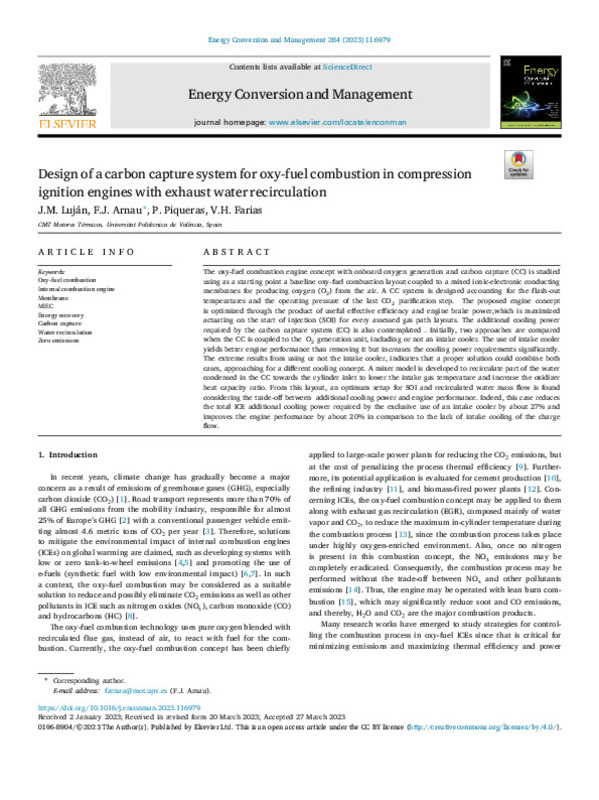Luján, JM.; Arnau Martínez, FJ.; Piqueras, P.; Farias-Da Silva, VH. (2023). Design of a carbon capture system for oxy-fuel combustion in compression ignition engines with exhaust water recirculation. Energy Conversion and Management. 284:1-19. https://doi.org/10.1016/j.enconman.2023.116979
Por favor, use este identificador para citar o enlazar este ítem: http://hdl.handle.net/10251/201537
|
Título:
|
Design of a carbon capture system for oxy-fuel combustion in compression ignition engines with exhaust water recirculation
|
|
Autor:
|

 Luján, José M.
Luján, José M.

 Arnau Martínez, Francisco José
Arnau Martínez, Francisco José

 Piqueras, P.
Piqueras, P.
 Farias-Da Silva, Vitor Hugo
Farias-Da Silva, Vitor Hugo
|
|
Entidad UPV:
|
Universitat Politècnica de València. Escuela Técnica Superior de Ingeniería del Diseño - Escola Tècnica Superior d'Enginyeria del Disseny
Universitat Politècnica de València. Escuela Técnica Superior de Ingenieros Industriales - Escola Tècnica Superior d'Enginyers Industrials
|
|
Fecha difusión:
|
|
|
Resumen:
|
[EN] The oxy-fuel combustion engine concept with onboard oxygen generation and carbon capture (CC) is studied using as a starting point a baseline oxy-fuel combustion layout coupled to a mixed ionic-electronic conducting ...[+]
[EN] The oxy-fuel combustion engine concept with onboard oxygen generation and carbon capture (CC) is studied using as a starting point a baseline oxy-fuel combustion layout coupled to a mixed ionic-electronic conducting membranes for producing oxygen (O2) from the air. A CC system is designed accounting for the flash-out temperatures and the operating pressure of the last CO2 purification step. The proposed engine concept is optimized through the product of useful effective efficiency and engine brake power,which is maximized actuating on the start of injection (SOI) for every assessed gas path layouts. The additional cooling power required by the carbon capture system (CC) is also contemplated . Initially, two approaches are compared when the CC is coupled to the O2 generation unit, including or not an intake cooler. The use of intake cooler yields better engine performance than removing it but increases the cooling power requirements significantly. The extreme results from using or not the intake cooler, indicates that a proper solution could combine both cases, approaching for a different cooling concept. A mixer model is developed to recirculate part of the water condensed in the CC towards the cylinder inlet to lower the intake gas temperature and increase the oxidizer heat capacity ratio. From this layout, an optimum setup for SOI and recirculated water mass flow is found considering the trade-off between additional cooling power and engine performance. Indeed, this case reduces the total ICE additional cooling power required by the exclusive use of an intake cooler by about 27% and improves the engine performance by about 20% in comparison to the lack of intake cooling of the charge flow.
[-]
|
|
Palabras clave:
|
Oxy-fuel combustion
,
Internal combustion engine
,
Membrane
,
MIEC
,
Energy recovery
,
Carbon capture
,
Water recirculation
,
Zero emissions
|
|
Derechos de uso:
|
Reserva de todos los derechos
|
|
Fuente:
|
Energy Conversion and Management. (issn:
0196-8904
)
|
|
DOI:
|
10.1016/j.enconman.2023.116979
|
|
Editorial:
|
Elsevier
|
|
Versión del editor:
|
https://doi.org/10.1016/j.enconman.2023.116979
|
|
Código del Proyecto:
|
info:eu-repo/grantAgreement/AEI//PID2021-123351OB-I00//DESARROLLO DE UNA PLANTA DE POTENCIA DE OXICOMBUSTIÓN CON CAPTURA DE CARBONO PARA PRODUCCIÓN DE ENERGÍA LIMPIA/
info:eu-repo/grantAgreement/GENERALITAT VALENCIANA//CIPROM%2F2021%2F061//DESARROLLO DE UNA PLANTA PROPULSIVA DE OXICOMBUSTIÓN CON CAPTURA DE CO2/
info:eu-repo/grantAgreement/GENERALITAT VALENCIANA//GRISOLIAP%2F2020%2F078//AYUDA SANTIAGO GRISOLIA: DESARROLLO DE UN MOTOR DE OXICOMBUSTION PARA AUTOMOCION LIBRE DE EMISIONES DE NOx./
|
|
Agradecimientos:
|
This work has been partially supported by Grant PID2021-123351OB-I00 funded by MCIN/AEI/10.13039/501100011033 and, as appropriate, by "ERDF A way of making Europe". In addition, the work has been supported by Grant ...[+]
This work has been partially supported by Grant PID2021-123351OB-I00 funded by MCIN/AEI/10.13039/501100011033 and, as appropriate, by "ERDF A way of making Europe". In addition, the work has been supported by Grant CIPROM/2021/061 funded by Generalitat Valenciana, Spain. Finally, the Ph.D. candidate Vitor Farias has been funded by Generalitat Valenciana, Spain (GRISOLIAP/2020/078) .
[-]
|
|
Tipo:
|
Artículo
|









